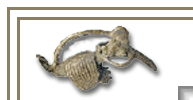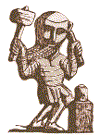PRIMITIVE MONEY
Money is a medium of exchange; that is, any item used to facilitate commerce, beyond a simple bartering of goods. It has taken many forms throughout history, including coins, tokens, paper currency, and those unusual items we call "primitive money". Mediums of exchange develop when any party wishing to obtain a certain item has nothing needed by the owner to barter in return.
Primitive moneys are items used in the same way that we use coins and tokens, but which do not have the mark of an issuing authority. They may or may not have an intrinsic value, but the culture that uses them accepts them even though the issuing authority, or backer, may not be known. Most primitive moneys are culture-specific and did not circulate over wide areas. Generally they developed as precursor to the development of a true coinage.

A true coin must meet three qualifications:
It must display the mark of the issuing authority who is responsible for redeeming the items.
It must be made from a material of a recognized value, and contain enough of that material for the intrinsic value to approach the circulating value (this is not limited to metal items). This allows the item to continue to be used even if the issuing authority ceases to exist.
It must be made to a recognized weight and purity standard, so that it can circulate without having to be weighed or tested at each transaction.

A token is an item which displays the mark of the issuing authority, but which represents a value, and is not unto itself a value. If the issuing authority ceases to exist, or ceases to honor the token, it becomes worthless (from a monetary point of view). One will notice that most modern "coins" and all paper money fall into this category.

The Americas
There are a number of forms of the Axtec Hoe money. There is no doubt at all that these were a form of money, as they were still in use when the Conquistadors arrived in the mid 1520's. There is a letter (I believe dated 1548) still in an archive in Toledo (Spain) on which one of the conquistadors wrote home and described them being used.

Africa
Africa has been the source of more types of primitive moneys than any other region of the world. Prior to the 19th century, true coins were used mainly in parts of north and northeast Africa, but the concept of money was well established throughout much of the continent. The use of primitive money was especially prolific in the area around the Congo basin and the Gold Coast regions.
"SLAVE" TRADE BRACELETS
On the west coast of Africa, from the Congo, north to Senegal, bronze bracelets (properly called Manillas) were worn both for personal adornment and for use as money. Their use dates back to at least the late 16th century and possibly much earlier. It is often difficult to date Manillas, but it is reasonable to assume that most of the specimens we come across today were made in the late 18th and 19th centuries, although some date to the early part of this century. A few areas were still using them as late as 1948, and we have heard rumors that they are occasionally still used in a few remote villages in Upper Volta.
They became known as "slave trade money" after the Europeans started using them to acquire slaves for the slave trade into the Americas (as well as England prior to 1807). The smaller types of the "Popo Manilla" were actually manufactured at Birmingham in England, specifically for the slave trade, and were too small to be worn.
We have a few types of bronze Bracelet money. Generally I cannot assign them to exact tribes or regions, but most are Nigeria or Congo, although such information will be recorded where available. All are native African made.
| 






